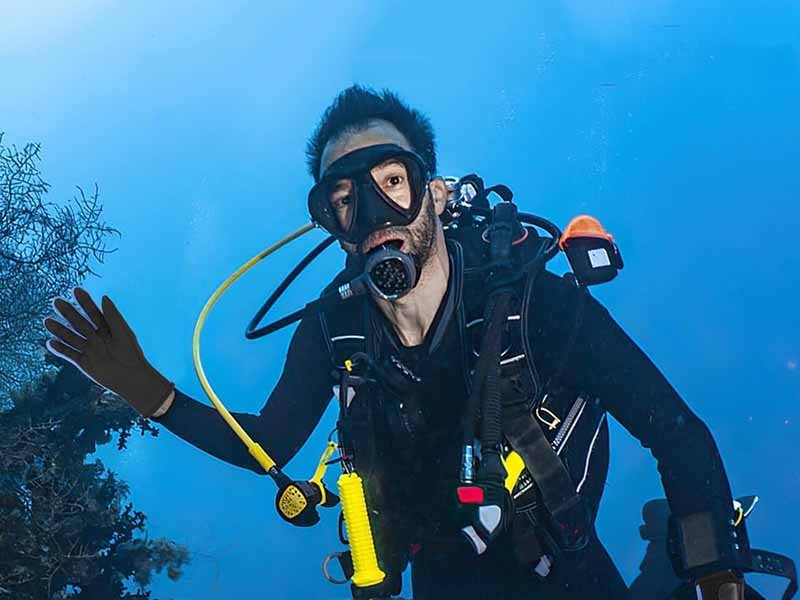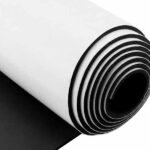When the water turns icy, even the strongest wetsuit can’t fully protect you—your hands become the weak link. Cold, stiff fingers can ruin a dive, limit your paddle power while surfing, or make it impossible to handle gear. This is where wetsuit gloves step in. Designed to provide insulation, grip, and dexterity, they are an essential part of cold-water gear for surfers, divers, and water sports enthusiasts. But not all wetsuit gloves are created equal—so how do you find the best ones?
The best wetsuit gloves balance warmth, grip, and flexibility. Neoprene gloves are most popular, with thickness options from 2 mm for mild waters to 7 mm for extreme cold. Styles include 5-finger gloves for dexterity, 3-finger lobster gloves for warmth plus movement, and mittens for maximum insulation. The “best” gloves depend on water temperature, sport, and comfort preference.
Picture this: you’re paddling into a perfect wave on a crisp winter morning. The swell is flawless, but after a few minutes, your hands feel like ice blocks. You miss your grip on the board, shivering instead of surfing. With the right pair of neoprene gloves, that session could have lasted hours. That’s the difference between gear that works and gear that just exists.
What Are Wetsuit Gloves And Why Do You Need Them?
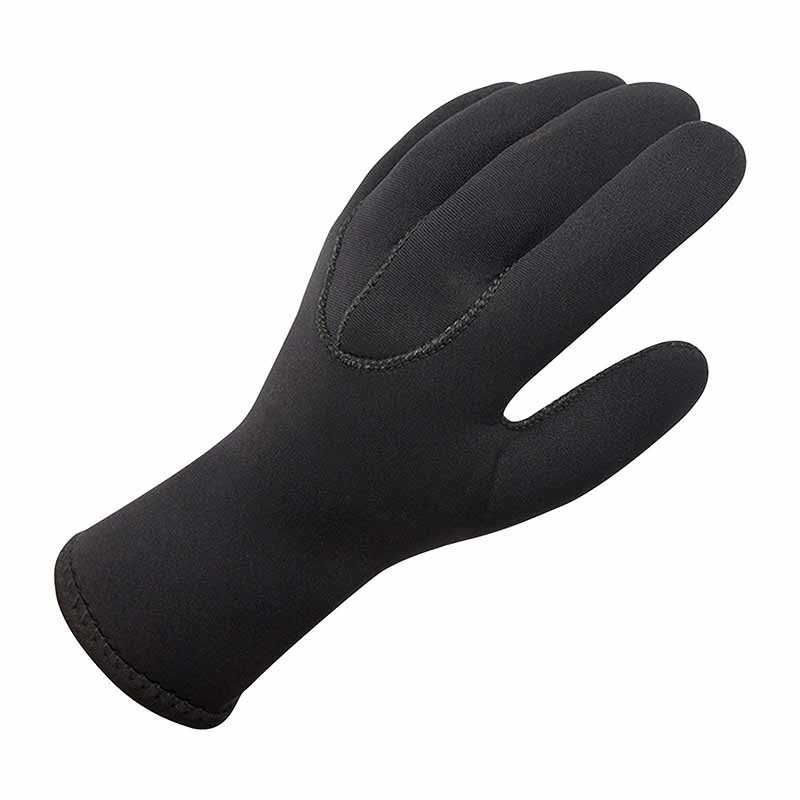
Wetsuit gloves are neoprene-based hand coverings designed to keep hands warm and protected in cold water. They work by insulating against heat loss, providing grip for paddling or handling equipment, and protecting skin from cuts or stings. Essential for surfing, diving, and kayaking in cold conditions, wetsuit gloves ensure safety, endurance, and performance when water temperatures drop.
At first glance, wetsuit gloves may seem like an optional accessory. After all, many beginners focus on wetsuits and boots. But ask any experienced surfer, diver, or kayaker, and they’ll tell you—hands are one of the first body parts to lose feeling in cold water. That loss of dexterity can mean the difference between enjoying your sport and cutting your session short.
1. What Are Wetsuit Gloves Made Of?
Most wetsuit gloves are constructed from neoprene, a closed-cell synthetic rubber that traps air bubbles to provide insulation. The thickness of neoprene determines the glove’s thermal efficiency:
- 2–3 mm: Light protection, best for mild waters.
- 5 mm: Balanced warmth and flexibility for moderate to cold conditions.
- 7 mm: Maximum insulation for freezing water.
2. Why They’re Needed
- Thermal Protection: Up to 20% of body heat can escape through the hands and head in cold water. Gloves slow that heat loss.
- Grip and Functionality: Textured palms improve hold on surfboards, paddles, or dive gear.
- Protection: Gloves prevent cuts from sharp reefs, rocks, or equipment, and reduce stings from marine life like jellyfish.
3. Sports Applications
- Surfing: Gloves help paddlers maintain grip and extend surf sessions.
- Diving: Essential for dives below 20°C (68°F), where cold water can cause numbness.
- Kayaking & Paddleboarding: Keep hands functional for paddling efficiency.
- Sailing & Windsurfing: Protect hands from both cold water and rope friction.
Why Wetsuit Gloves Are Essential
| Function | Benefit for User |
|---|---|
| Insulation | Maintains hand warmth in cold waters |
| Grip | Prevents slipping on boards or equipment |
| Dexterity | Allows handling gear and safety equipment |
| Protection | Shields against cuts, stings, and abrasions |
Which Types Of Wetsuit Gloves Are Available?
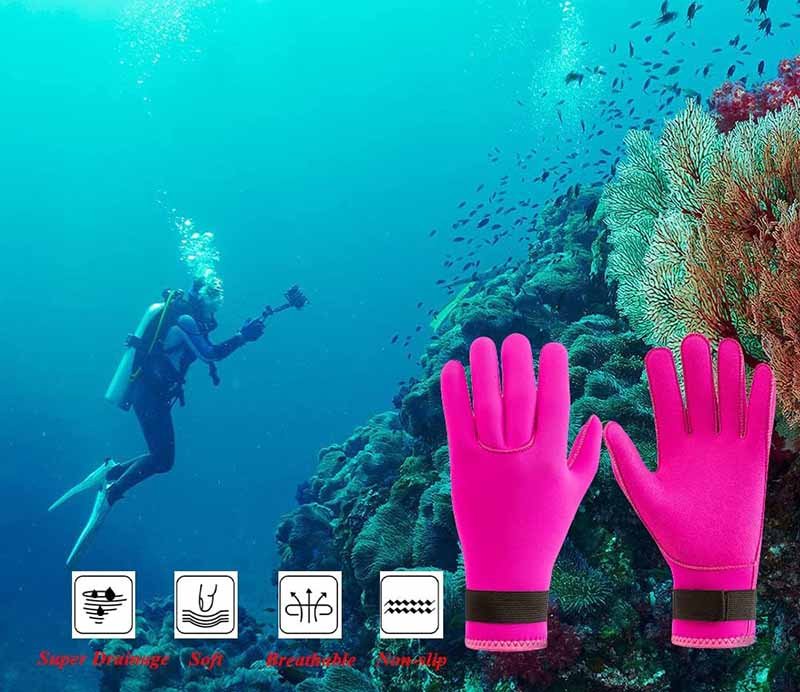
Wetsuit gloves come in three main types: 5-finger gloves for full dexterity, 3-finger “lobster” gloves that balance warmth and mobility, and mittens that maximize insulation but reduce finger movement. The best type depends on your sport and water temperature: surfers often prefer lobster gloves, divers rely on mittens in extreme cold, and general water sports users choose 5-finger gloves for flexibility.
Choosing the right type of wetsuit glove isn’t only about comfort—it’s about how much movement and warmth you need. Each glove type has a trade-off between dexterity and insulation.
1. Five-Finger Gloves
- Design: Each finger is separated like a normal glove.
- Advantages: Best dexterity for gripping paddles, adjusting dive equipment, or surfing.
- Drawbacks: More surface area = more heat loss, making them less warm than other types.
- Best For: Kayaking, paddleboarding, surfing in mild to moderate cold.
2. Three-Finger “Lobster” Gloves
- Design: Index finger separate, the other three fingers grouped together.
- Advantages: Warmer than five-finger gloves while still offering reasonable dexterity.
- Drawbacks: Slightly awkward for fine movements.
- Best For: Cold-water surfing and open-water swimming where balance of warmth + grip matters.
3. Mittens
- Design: All fingers grouped together in one compartment.
- Advantages: Maximum warmth, minimal heat loss.
- Drawbacks: Severely reduces dexterity; difficult to adjust gear.
- Best For: Diving or surfing in extreme cold conditions (below 10°C / 50°F).
Comparison of Wetsuit Glove Types
| Glove Type | Warmth Level | Dexterity Level | Best Use Case |
|---|---|---|---|
| 5-Finger Gloves | ★★★☆☆ | ★★★★★ | Surfing, kayaking, moderate temps |
| 3-Finger (Lobster) | ★★★★☆ | ★★★★☆ | Cold-water surfing, swimming |
| Mittens | ★★★★★ | ★★☆☆☆ | Diving in extreme cold water |
How Do Wetsuit Gloves Keep Your Hands Warm In Cold Water?
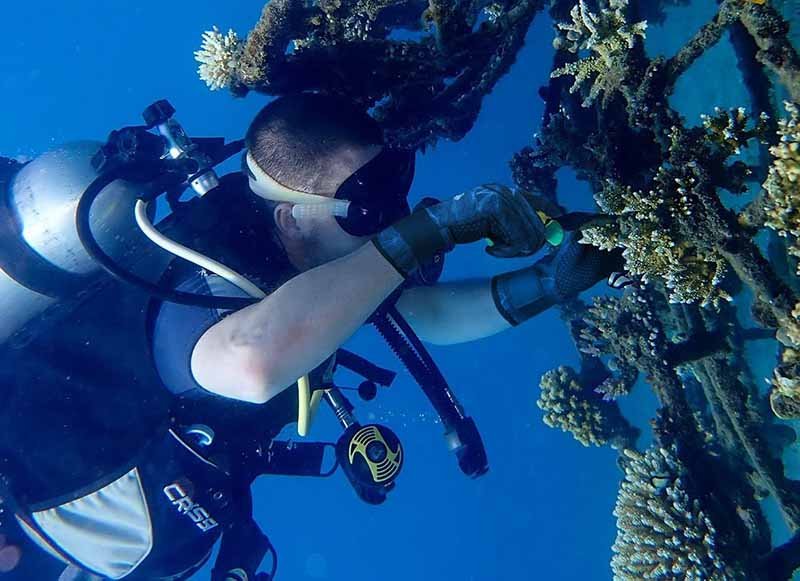
Wetsuit gloves keep hands warm by using neoprene’s insulating properties. They trap a thin layer of water inside the glove, which warms from body heat, while the neoprene foam prevents further heat loss. Sealed seams and thicker neoprene improve insulation, reducing cold water circulation. By slowing down heat transfer, wetsuit gloves extend hand function and endurance in cold environments.
The principle behind wetsuit gloves is similar to wetsuits themselves: controlled insulation.
1. Neoprene Insulation
- Neoprene contains tiny closed cells filled with nitrogen gas, which reduce heat conduction.
- Thicker neoprene = better insulation.
- Standard glove thickness: 2 mm (light use) to 7 mm (extreme cold diving).
2. The Trapped Water Layer
- When water enters the glove, it doesn’t freely circulate.
- Body heat quickly warms this thin layer, creating a thermal buffer.
- Gloves without proper seals lose warmth as water flushes in and out.
3. Seam Construction
- Flatlock Stitching: Flexible but allows some water seepage, good for warmer waters.
- Glued and Blind-Stitched (GBS): Seams glued then stitched halfway through neoprene, limiting water entry.
- Liquid-Sealed Seams: Coated for maximum waterproofing, best for very cold water.
4. Additional Warmth Factors
- Lining: Thermal linings (fleece-like interiors) add comfort and warmth.
- Cuff Design: Extended cuffs prevent water from flushing into gloves during movement.
- Glove Fit: Snug fit is critical—too loose, and water flows freely; too tight, circulation is restricted.
Wetsuit Glove Warmth Factors
| Factor | Impact on Warmth | Ideal Choice |
|---|---|---|
| Thickness | Higher thickness = more heat | 5–7 mm for cold dives |
| Seam Type | Sealed seams retain heat | GBS or liquid-sealed for <15°C |
| Lining | Adds insulation comfort | Thermal fleece for endurance |
| Fit | Prevents water flushing | Snug but not circulation-cutting |
What Features Should You Look For In The Best Wetsuit Gloves?
The best wetsuit gloves should balance thickness, grip, flexibility, seam sealing, and durability. Choose 2–3 mm gloves for mild water, 5 mm for cold, and 7 mm for extreme conditions. Look for textured palms for grip, glued or liquid-sealed seams for insulation, and thermal linings for comfort. A snug but non-restrictive fit is critical—too loose allows water flushing, too tight restricts blood flow.
Selecting the right wetsuit gloves goes beyond size—it’s about choosing features that match your sport and environment.
1. Neoprene Thickness
- 2–3 mm: Warm-water surfing, snorkeling, and kayaking.
- 5 mm: Standard for divers and surfers in 10–18°C (50–64°F).
- 7 mm: Extreme cold, ice diving, or Arctic conditions.
- Trade-off: The thicker the neoprene, the warmer but less flexible the glove.
2. Seam Sealing
- Flatlock Stitching: Comfortable, breathable, but not watertight—ideal for warm waters.
- GBS (Glued & Blind Stitched): Prevents most leaks, suitable for cold water.
- Liquid-Sealed Seams: Maximum waterproofing and durability for icy conditions.
3. Grip & Palm Coatings
- Textured Rubber Palms: Essential for surfers and kayakers needing paddle control.
- Smooth Palms: Preferred by divers for equipment manipulation.
4. Inner Linings
- Standard Nylon: Durable but less warm.
- Thermal Linings (fleece-like): Increase warmth and comfort.
- Quick-Dry Linings: Reduce drying time between sessions.
5. Fit & Cuff Design
- Extended Cuffs: Tuck into wetsuit sleeves to prevent water flushing.
- Velcro or Seal Straps: Improve snugness but can reduce flexibility.
- Anatomical Pre-Curved Shape: Reduces hand fatigue during long sessions.
Key Features to Consider When Buying Wetsuit Gloves
| Feature | Options | Best Use Case |
|---|---|---|
| Thickness | 2–3 mm / 5 mm / 7 mm | Warm / Cold / Extreme cold waters |
| Seam Type | Flatlock / GBS / Liquid | Warm / Cold / Very cold diving |
| Palm Grip | Textured / Smooth | Surfing & kayaking / Diving |
| Lining | Nylon / Thermal / Quick-dry | Durability / Warmth / Convenience |
| Cuff Design | Short / Extended | Warm water / Cold water with wetsuit |
Which Brands Make The Best Wetsuit Gloves?
Top wetsuit glove brands include O’Neill, Rip Curl, Xcel, Cressi, and Mares. For surfers, O’Neill Psycho Tech and Rip Curl Flashbomb gloves are highly rated. For divers, Cressi and Mares produce durable 5–7 mm gloves with sealed seams. Xcel is known for lobster-style gloves balancing warmth and dexterity. The best brand depends on whether you surf, dive, or paddle in cold waters.
The wetsuit glove market is competitive, with different brands specializing in different sports. Here’s how they compare:
1. Surfing-Oriented Brands
- O’Neill: Known for flexibility and comfort. Their Psycho Tech 5 mm gloves are a surfer favorite.
- Rip Curl: The Flashbomb series includes quick-dry linings and excellent insulation.
- Xcel: Popular for lobster-style gloves, offering warmth without sacrificing too much grip.
2. Diving-Oriented Brands
- Cressi: Italian brand offering durable, anatomically shaped gloves for scuba diving.
- Mares: Focuses on cold-water diving, with reinforced palms for handling equipment.
- Scubapro: Known for high-end diving gear, including thick 5–7 mm gloves.
3. Multi-Sport Options
- O’Neill & Xcel: Great crossover for surfers and open-water swimmers.
- Fourth Element: Specializes in eco-friendly neoprene, suitable for divers and triathletes.
Brand Comparison: Surf vs Dive Focus
| Brand | Strengths | Best Use Case |
|---|---|---|
| O’Neill | Flexibility, surf performance | Surfing in cold water |
| Rip Curl | Warmth, quick-dry tech | Surfing, extended sessions |
| Xcel | Lobster-style, balance | Surfing & swimming in cold water |
| Cressi | Diving durability | Recreational scuba diving |
| Mares | Thick, reinforced gloves | Cold-water scuba & freediving |
| Scubapro | High-end, premium insulation | Technical or professional diving |
Do Wetsuit Gloves Affect Performance In The Water?
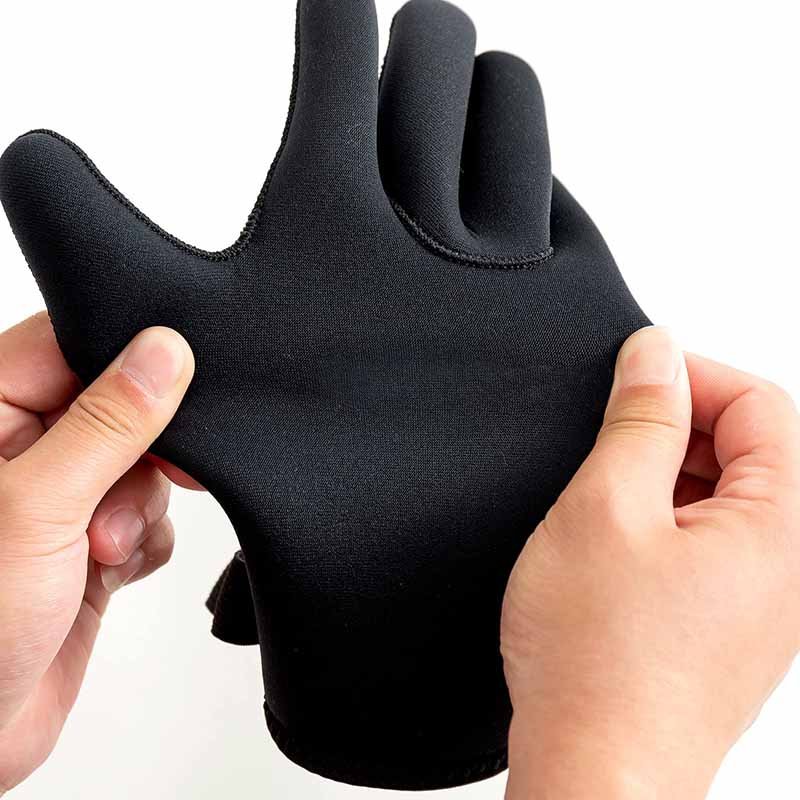
Yes, wetsuit gloves can affect performance by adding warmth and grip but sometimes reducing dexterity and increasing drag. Thin gloves (2–3 mm) provide flexibility for paddling or handling gear, while thick gloves (5–7 mm) maximize insulation but may limit hand movement. For most surfers, divers, and paddlers, the performance gains from warmth and endurance outweigh the slight reduction in speed or dexterity.
The impact of wetsuit gloves on performance depends on thickness, design, and activity type.
1. Dexterity vs Warmth Trade-Off
- Thin gloves (2–3 mm): High dexterity but limited warmth.
- Thick gloves (5–7 mm): Maximum warmth but stiffer movement.
- Surfers often compromise with 3–5 mm gloves, while divers in extreme cold prioritize thickness.
2. Grip and Control
- Textured palms improve control on boards, paddles, and dive equipment.
- Divers benefit from reinforced palms for tank valves, spearguns, or cameras.
- Surfers need non-slip grip to push up smoothly when catching waves.
3. Hydrodynamic Drag
- Gloves increase hand surface area slightly, adding resistance in the water.
- Competitive swimmers avoid them, but for surfers and divers, the effect is negligible compared to warmth benefits.
4. Endurance Benefits
- Cold hands fatigue quickly, reducing paddle power or dive time.
- Gloves conserve energy, letting athletes perform longer and safer.
- In sub-15°C water, gloves are often the difference between finishing a session or abandoning it.
Performance Impact by Glove Thickness
| Thickness | Dexterity | Warmth | Performance Trade-Offs |
|---|---|---|---|
| 2–3 mm | ★★★★★ | ★★☆☆☆ | Great movement, limited insulation |
| 5 mm | ★★★★☆ | ★★★★☆ | Balanced choice for most conditions |
| 7 mm | ★★☆☆☆ | ★★★★★ | Max warmth, reduced dexterity |
Are Wetsuit Gloves Necessary For Surfing, Diving, And Other Sports?
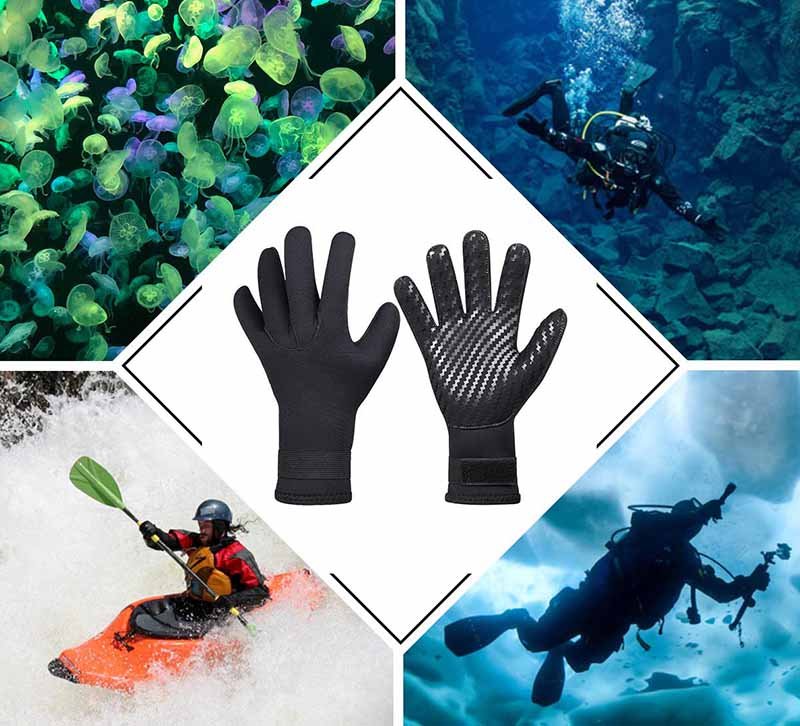
Wetsuit gloves are necessary for cold-water surfing, scuba diving, kayaking, and other watersports when temperatures drop below 18°C (65°F). They extend session length by keeping hands warm and functional. While not required in warm climates or heated pools, they are essential safety gear in cold seas, preventing numbness, reduced grip, and early fatigue.
Whether or not wetsuit gloves are necessary depends on your sport and water temperature.
1. Surfing
- In cold climates, gloves are essential.
- Without them, hands become stiff, making paddling and board handling difficult.
- Lobster gloves (3-finger) are especially popular among surfers in water below 12–15°C.
2. Scuba Diving
- Gloves are critical for dives below 20°C (68°F).
- They prevent numbness, help maintain dexterity for safety equipment, and shield hands from sharp rocks or coral.
- For ice diving, 7 mm gloves or mittens are standard.
3. Kayaking & Paddleboarding
- Gloves help maintain paddle grip during long sessions in cold rivers or seas.
- Reduce blistering and protect against rope friction.
4. Sailing & Windsurfing
- Dual role: warmth and rope handling protection.
- Neoprene gloves are often reinforced at the palms for durability.
5. Recreational Swimming
- Casual swimmers don’t always need gloves.
- In open-water swims below 16°C (60°F), gloves extend safe swim time.
Sports Requiring Wetsuit Gloves
| Sport | Necessary? | Best Glove Type |
|---|---|---|
| Surfing | Yes (cold water) | 3–5 mm, lobster gloves |
| Diving | Yes (<20°C) | 5–7 mm, mittens or 5-finger |
| Kayaking | Yes (cold water) | 3–5 mm with grip palms |
| Paddleboarding | Yes (cold water) | 2–3 mm for flexibility |
| Sailing | Yes (rope use) | Reinforced neoprene gloves |
| Swimming (casual) | Not always | Optional, thin gloves only |
How To Choose The Right Wetsuit Gloves For Your Needs?
To choose the right wetsuit gloves, match glove thickness and type to your sport and water temperature. Use 2–3 mm gloves for mild waters, 5 mm for cold, and 7 mm for extreme conditions. Select five-finger gloves for dexterity, lobster gloves for warmth plus movement, and mittens for maximum insulation. Check for sealed seams, textured palms, and a snug but comfortable fit.
Picking the wrong wetsuit gloves can ruin your session. Too thin, and your hands freeze; too thick, and you can’t paddle or adjust gear. Here’s a structured way to choose the right pair:
1. Match Thickness to Water Temperature
- Above 18°C (65°F): 2–3 mm gloves are sufficient.
- 10–18°C (50–64°F): 5 mm gloves balance warmth and dexterity.
- Below 10°C (50°F): 7 mm gloves or mittens are essential.
2. Choose the Right Style
- Five-Finger Gloves: For maximum movement, best for kayaking, paddleboarding, and mild surfing.
- Lobster Gloves: For surfers in cold seas who need grip and insulation.
- Mittens: For divers in freezing waters where warmth is critical.
3. Look for Key Features
Seam Type:
- Flatlock = flexible, but not watertight.
- GBS (glued & blind stitched) = good for cold water.
- Liquid sealed = best for icy dives.
Palm Grip: Rubberized or textured palms for surfers/kayakers.
Cuff Design: Extended cuffs prevent water flushing.
4. Fit & Comfort
- Gloves should be snug but not cut off circulation.
- Try different sizes—brands vary in fit.
- Pre-curved anatomical designs reduce hand fatigue.
Wetsuit Glove Buying Guide
| Water Temp | Thickness | Best Style | Key Features |
|---|---|---|---|
| >18°C / 65°F | 2–3 mm | Five-finger | Flexible seams, light grip |
| 10–18°C / 50–64°F | 5 mm | Lobster or 5-finger | GBS seams, textured palm |
| <10°C / 50°F | 7 mm | Mittens | Liquid-sealed, long cuff |
Conclusion
Wetsuit gloves are more than accessories—they’re essential gear for anyone venturing into cold waters. The “best” gloves depend on your needs: lightweight five-finger gloves for flexibility, lobster gloves for balance, or mittens for maximum warmth. With the right gloves, you gain endurance, grip, and safety, allowing you to surf, dive, or paddle longer in comfort.
At Szoneier, we’ve spent over 18 years mastering neoprene product design, research, and manufacturing. Our neoprene gloves are trusted by water sports brands and adventurous swimmers worldwide. Whether you’re building a custom line of wetsuit gloves or sourcing OEM/ODM solutions, we bring unmatched expertise.
If you’re ready to design or source custom neoprene wetsuit gloves, let Szoneier help bring your vision to life.

